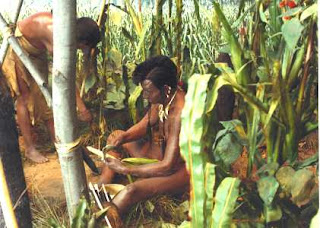Grow A Three Sisters Garden
(from Nativetech)
According to Native American legend, corn, beans, and squash are three inseparable sisters who grow and thrive together.When planted together, the Three Sisters all help each other - the corn stalk serves as a pole for the beans, the beans help to add the nitrogen to the soil that the corn needs, and the squash provides a ground cover of shade that helps the soil retain moisture.
(courtesy of HumanFlowerProject)
 According to Three Sisters tradition, corn must grow in community with other crops rather than on its own. Why? Most thought it was because corn needed the nitrogen in the soil that beans supply but there is another reason. Corn, the primary crop of mesoamericans, provides more calories or energy per acre than any other plant but lacks the amino acids lysine and tryptophan, which the body needs to make proteins. Beans, however, contain both and therefore together these two they provide a balanced diet.
According to Three Sisters tradition, corn must grow in community with other crops rather than on its own. Why? Most thought it was because corn needed the nitrogen in the soil that beans supply but there is another reason. Corn, the primary crop of mesoamericans, provides more calories or energy per acre than any other plant but lacks the amino acids lysine and tryptophan, which the body needs to make proteins. Beans, however, contain both and therefore together these two they provide a balanced diet.
Thus, this tradition of interplanting corn, beans and squash in the same mounds, is a sophisticated, sustainable system that provides long-term soil fertility and a healthy food supply!
Bean vines also stabilize the corn plants, making them less vulnerable to blowing over in the wind and spiny squash plants discourage predators from approaching the corn and beans. Addiitonally, the large amount of crop residue from this planting combination can be incorporated back into the mound at the end of the season, to build up the organic matter in the soil and improve its structure.
 According to Three Sisters tradition, corn must grow in community with other crops rather than on its own. Why? Most thought it was because corn needed the nitrogen in the soil that beans supply but there is another reason. Corn, the primary crop of mesoamericans, provides more calories or energy per acre than any other plant but lacks the amino acids lysine and tryptophan, which the body needs to make proteins. Beans, however, contain both and therefore together these two they provide a balanced diet.
According to Three Sisters tradition, corn must grow in community with other crops rather than on its own. Why? Most thought it was because corn needed the nitrogen in the soil that beans supply but there is another reason. Corn, the primary crop of mesoamericans, provides more calories or energy per acre than any other plant but lacks the amino acids lysine and tryptophan, which the body needs to make proteins. Beans, however, contain both and therefore together these two they provide a balanced diet.Thus, this tradition of interplanting corn, beans and squash in the same mounds, is a sophisticated, sustainable system that provides long-term soil fertility and a healthy food supply!
The wonderful website Nativetech provides simple instructions for planting a Three Sisters garden. This information comes from them - I modified it a little.
(me - a long time ago in my vegie garden)
 1. In spring, turn over the soil and heap the earth into mounds about a foot high and about 20" across. The centers of your mounds should be about five feet apart and should have flattened tops.
1. In spring, turn over the soil and heap the earth into mounds about a foot high and about 20" across. The centers of your mounds should be about five feet apart and should have flattened tops. 2. In the center of each mound, plant five or six corn kernels in a small circle.
3. After a week or two, when the corn has grown to be five inches or so, plant seven or eight pole beans in a circle about six inches away from the corn kernels.
4. A week later, at the edge of the mound about a foot away from the beans, plant seven or eight squash or pumpkin seeds.
5. When the plants begin to grow, weed out all but a few of the sturdiest of the corn plants from each mound. Also keep the sturdiest of the bean and squash plants and weed out the weaker ones.
6. As the corn and beans grow up, make sure that the beans are supported by cornstalks, wrapping around the corn. The squash will crawl out between the mounds, around the corn and beans.
Renee's garden also offers instructions on planting on their website and sells this packet of seeds.
The Iroquois believe corn, beans and squash are precious gifts from the Great Spirit, each watched over by a sister or 'sustainer' spirit ( called 'De-o-ha-ko').
In truth it should be known as The Three Sustainers garden....a sustainability landscape indeed!
(courtesy of New York State Museum)















Wonderful post! I'm charmed by the idea of a sister or sustainer spirit inhabiting this trio -- which are truly great gifts for us all. :D
ReplyDeletecharmed, yes...I like that word.
ReplyDeleteto think they figured out the complex amino acid requirements through a simple planting tradition...
Last year I tried this method for the first time, with some success. I just wondered why they have to be grown on a mound. Any reason or just tradition?
ReplyDeleteCheers
Jannie
I surmise that it is easier to create loose soil for the roots to grow through if some of it is maounded. Also the squash is elevated a little so if it rains, the water rolls off it easily.
ReplyDelete